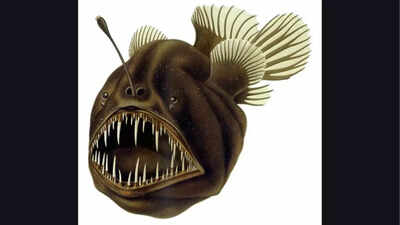Trending
The terrifying black seadevil anglerfish and its unique traits
The black seadevil anglerfish, a deep-sea predator with bioluminescent lure, sharp teeth, and unique adaptations, survives in extreme ocean depths. Notably, its bioluminescent lure attracts prey, while males fuse with females through parasitic mating. Rarely seen, this species fascinates scientists, highlighting the need for further deep-sea exploration and research to uncover more about its mysterious world.
Deep in the ocean’s pitch-black depths lurks a creature straight out of a horror movie—the black seadevil anglerfish. With its ghostly glow, razor-sharp teeth, and an eerie bioluminescent lure dangling from its head, this deep-sea predator is as terrifying as it is fascinating. Living thousands of feet below the surface, it survives in near-total darkness, using its glowing lure to attract unsuspecting prey. Despite its monstrous appearance, the black seadevil is rarely seen, making every sighting a scientific wonder. What secrets does this mysterious fish hold? Dive into the abyss as we uncover the haunting world of this deep-sea nightmare.
Black seadevil anglerfish: 5 fascinating features of this mysterious creature
Black seadevil anglerfish: Bioluminescent lure
The Black Seadevil anglerfish, scientifically known as Melanocetus johnsonii, is renowned for its bioluminescent lure, or esca, which protrudes from its head. This lure is a modified dorsal fin ray that houses symbiotic bacteria capable of producing light. The anglerfish uses this glowing appendage to attract prey in the deep, dark ocean depths where sunlight cannot penetrate. This adaptation is crucial for survival in an environment where food is scarce. The light emitted by the esca mimics the bioluminescence of smaller prey, luring unsuspecting fish and crustaceans close enough for the anglerfish to strike with its large, gaping mouth.
Black seadevil anglerfish: Sexual dimorphism and parasitic mating
One of the most fascinating aspects of the Black Seadevil anglerfish is its extreme sexual dimorphism. Females are significantly larger than males, sometimes up to ten times their size. Males are so small that they lack the characteristic bioluminescent lure. Instead, they have highly developed olfactory organs to detect pheromones released by females. Once a male locates a female, he latches onto her body using his sharp teeth. Over time, the male's body fuses with the female's, and he becomes a permanent parasite, providing sperm in exchange for nutrients. This unique reproductive strategy ensures that the female has a constant supply of sperm for fertilization in the vast, sparsely populated deep sea.
Black seadevil anglerfish: Adaptations to extreme pressure
The Black Seadevil anglerfish thrives in the deep sea, where pressures can exceed 1,000 atmospheres. To survive in such an extreme environment, the anglerfish has evolved several physiological adaptations. Its body is highly compressible, with a gelatinous texture that allows it to withstand immense pressure without being crushed. Additionally, its bones are thin and lightweight, reducing the risk of structural damage. The anglerfish's swim bladder, which helps most fish regulate buoyancy, is either greatly reduced or absent, as it would collapse under the extreme pressure. Instead, the anglerfish relies on its large, oil-filled liver to maintain buoyancy, allowing it to hover effortlessly in the water column.
Black seadevil anglerfish: Carnivorous feeding habits
The Black Seadevil anglerfish is a voracious predator, feeding on a variety of deep-sea creatures, including fish, crustaceans, and cephalopods. Its large, expandable mouth and sharp, inward-pointing teeth ensure that once prey is captured, it cannot escape. The anglerfish's stomach is also highly elastic, allowing it to consume prey larger than itself. This ability to eat large meals is crucial in the deep sea, where food is scarce and encounters with prey are infrequent. The anglerfish's feeding strategy is opportunistic; it relies on its bioluminescent lure to attract prey and its stealthy approach to ambush them, making it a highly effective predator in its dark, inhospitable habitat.
Black seadevil anglerfish: Elusive and rarely seen
Despite its fearsome appearance, the Black Seadevil anglerfish is rarely encountered by humans due to its deep-sea habitat, which can range from 1,000 to 3,000 meters below the surface. Most of what is known about this species comes from specimens brought to the surface by deep-sea trawlers or remotely operated vehicles (ROVs). The anglerfish's elusive nature makes it a subject of great interest to marine biologists and deep-sea explorers. Its ability to survive in such a hostile environment, combined with its unique adaptations, makes the Black Seadevil a fascinating example of the extremes of evolutionary adaptation. However, much about its behavior, life cycle, and ecology remains a mystery, highlighting the need for further deep-sea exploration and research.
Also Read: Babies can identify language differences at just 4 months old, research reveals

About the Author
TOI Lifestyle DeskEnd of Article
FOLLOW US ON SOCIAL MEDIA
Visual Stories
Tired of too many ads?






